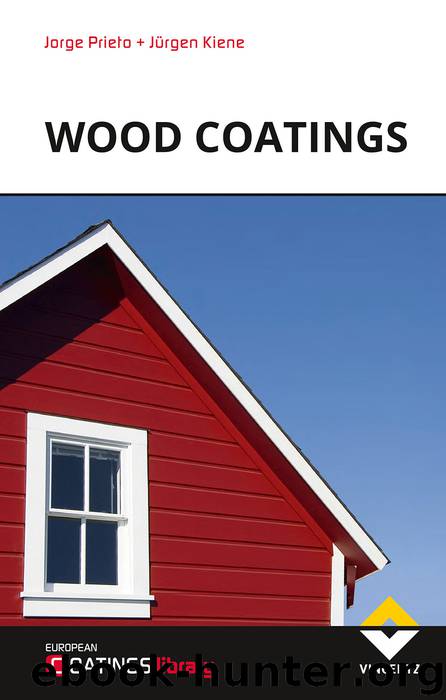Wood Coatings by Jorge Prieto

Author:Jorge Prieto
Language: eng
Format: epub
Publisher: Vincentz Network
Published: 2018-06-11T16:00:00+00:00
Figure 3.106: Powder film on a narrow edge of a MDF with a too low density in the depth[321]
Figure 3.107: REM picture of beech fibres[321]
Figure 3.108: REM picture of spruce fibres[321]
The feature of MDF depends on press parameters such as rate of compression, warming up of a fleece, and rate of evaporation. From this, in addition to the desirable properties, also undesirable may result for the MDF. Figure 3.105 exemplary presents two grades of MDF which distinguish due to the different bulk density profiles caused by different rates of compression.
For example, for the direct coating, the initially decreasing and subsequently increasing bulk density in the left bulk density profile is less suitable than the more homogeneous profile since the pronounced minimum in the bulk density profile in the left diagram may favour cracks in the coating. Figure 3.106 presents a powder coated narrow edge of a MDF plate having a too low density in the depth. Here, the untreated narrow edge cannot be painted completely with a powder coating film since the coating penetrates up to 300 µm into the MDF plate.
Depending on the type and manufacturer, the MDF substrates not only have a different bulk density distribution. The following items have a significant influence on the quality of the MDF substrates:
– Bulk density profile (gradation in density vertical to the plane of the MDF plate)
– Adhesive system (PMDI resin, UF resin, MUF resin or PF resin)
– Fibrous structure
– Used hydrophobing agent
A good wetting behaviour of a substrate is a prerequisite for a faultless, optically attractive surface. Not least, the morphology of the wood fibre is responsible for this (see Figures 3.107 and 3.110). In this example, the fibre length of the spruce wood amounts approx. 3 mm while the fibre length of beech wood amounts approx. 1 mm here. The gluing of the wood fibres in the blow-line only is performed selectively, so that the longer spruce fibres may dissolve themselves from the composite due to an electrostatic application of the powder coating and straighten up. This results in unintended surface defects.
Thus, a fine fibre quality is an important feature of quality of a powder coatable MDF plate. Recent findings [361] show that the wood species is not crucial but above all the geometries of the fibres. Actually, a single-layer coating with a sufficient quality only can be realized by application of a MDF adapted to a powder coating.
At present, a lot of manufacturers of MDF boards work intensively on the production of powder coatable types of MDF boards which are characterized by the following specifications:
– Fine fibre quality
– Mean bulk density of at least 780 kg/m3
– Preferably regular bulk density profile
– Electrostatic conductivity at a low moisture content, for example by application of modified resins or by using additives
– 24 h swelling in thickness (EN 317) < 6 %
– Transverse tensile strength (DIN EN 317) > 1,0 N/m2 (Note: This also is valid for wet coatings)
It can be summarized that the finer the fibres were ground in the
Download
This site does not store any files on its server. We only index and link to content provided by other sites. Please contact the content providers to delete copyright contents if any and email us, we'll remove relevant links or contents immediately.
Quantitative and Pattern Recognition Analyses of Five Marker Compounds in Raphani Semen using High-Performance Liquid Chromatography by Unknown(4117)
Alchemy and Alchemists by C. J. S. Thompson(3481)
The Elements by Theodore Gray(3025)
The Club by A.L. Brooks(2892)
How to Make Your Own Soap by Sally Hornsey(2866)
Drugs Unlimited by Mike Power(2564)
Wheels of Life by Anodea Judith(2115)
Cracking the LSAT, 2012 Edition by Princeton Review(1913)
Cracking the Sat French Subject Test, 2013-2014 Edition by The Princeton Review(1847)
Perfume by Jean-Claude Ellena(1800)
The Flavor Matrix by James Briscione(1796)
The Cosmic Machine: The Science That Runs Our Universe and the Story Behind It by Scott Bembenek(1740)
MCAT Physics and Math Review by Princeton Review(1657)
1000 Multiple-Choice Questions in Organic Chemistry by Organic Chemistry Academy(1640)
The Thing Around Your Neck by Chimamanda Ngozi Adichie(1638)
Cracking the SAT Premium Edition with 6 Practice Tests, 2017 by Princeton Review(1562)
Handbook of Modern Sensors by Jacob Fraden(1559)
Synchrotron Light Sources and Free-Electron Lasers by Eberhard J. Jaeschke Shaukat Khan Jochen R. Schneider & Jerome B. Hastings(1537)
A is for Arsenic: The Poisons of Agatha Christie (Bloomsbury Sigma) by Kathryn Harkup(1525)
